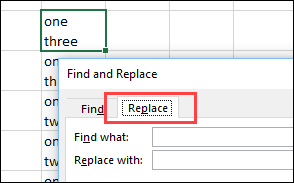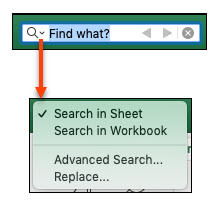

- #Where is the find and replace in excel 2016 for mac how to#
- #Where is the find and replace in excel 2016 for mac for mac#
- #Where is the find and replace in excel 2016 for mac pro#
You can change the size of the Table by clicking and dragging the bracket at the bottom left corner of the Table. Excel asks if your table has headers, then it applies a Table style (the yellow style is shown below), it adds AutoFilter dropdown arrows to the field headers, and it puts a small backwards “L” bracket at the bottom right corner of the table. To get your data into a table, you select it (or select one cell and let Excel figure out how far it stretches), and on the Insert tab of the ribbon, click Table. The screenshot below shows the same data and chart as above, but the data is now in a Table. In Excel 2007, Lists became known as “Tables”, and their capabilities have been expanded in every version since. Lists became the favored source data for charts and also for pivot tables. You could sort and filter your data range easily, and any formula that used a whole column of your List updated to automatically keep using that whole column of the list. These lists were a more structured container for your data, with a database structure of fields (columns) and records (rows), field headers (column headers) and filtering tools. Tables made their appearance in Excel 2003, and were called “Lists”. The easiest way to make a chart’s contents reflect the size of a range of data is to put the data into a Table.

#Where is the find and replace in excel 2016 for mac how to#
I’ll describe how to make dynamic charts using Tables, using Names, and using Names in a more flexible way. Using Names can lead to more flexibility in defining the data in your charts. A bit more complicated is to use Excel’s Names to define the series data for your chart. The easiest way is to use Tables as the chart source data. There are a couple ways to create charts that will grow with your data. If the data in the cells changes, so does the chart, but if the data extends to more cells (or shrinks to fewer cells), the chart doesn’t seem to notice. But once you’ve created a chart, it keeps plotting data from the same cells. It’s pretty easy to set up data and create a chart in Excel. This exercise was done completely in Mac Excel 2016, and other than not knowing a few of the shortcuts I use everyday, it was not very different from working in Windows Excel 2016.
#Where is the find and replace in excel 2016 for mac for mac#
The protocols are the same for Mac Excel and Windows Excel, and perhaps it’s time for a quick review.
#Where is the find and replace in excel 2016 for mac pro#
So I dusted off my MacBook Pro and tried it out.īottom line: There are several ways to make dynamic charts in Excel, and there seems to be no difference other than cosmetic in how they work between different versions of Excel, and between operating system. Good question, and I wondered if he’d encountered some unexpected problem, perhaps a bug, in Mac Excel. A reader emailed to ask whether you could make a dynamic chart using OFFSET-function-based Names in Excel 2016 for Mac.


 0 kommentar(er)
0 kommentar(er)
